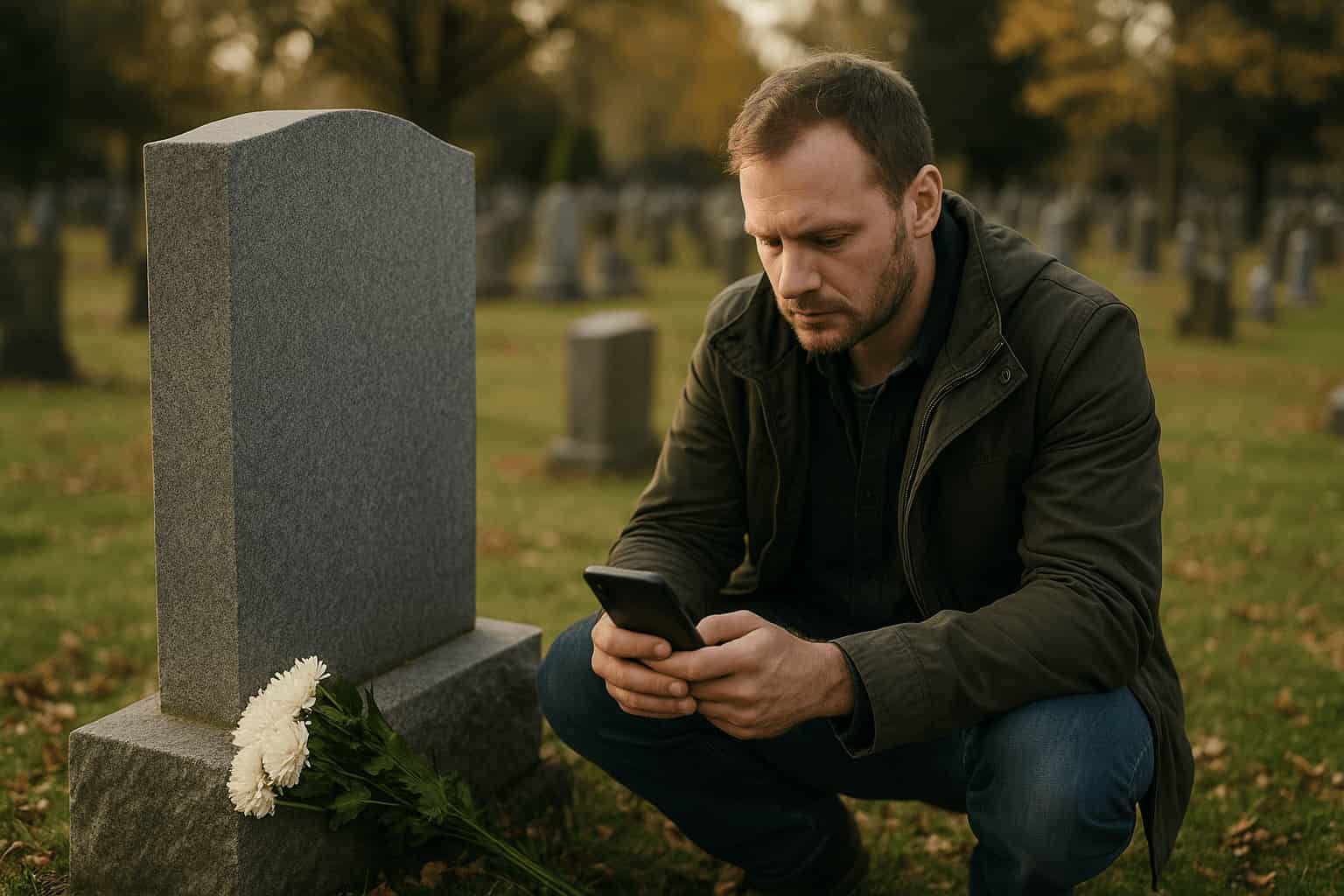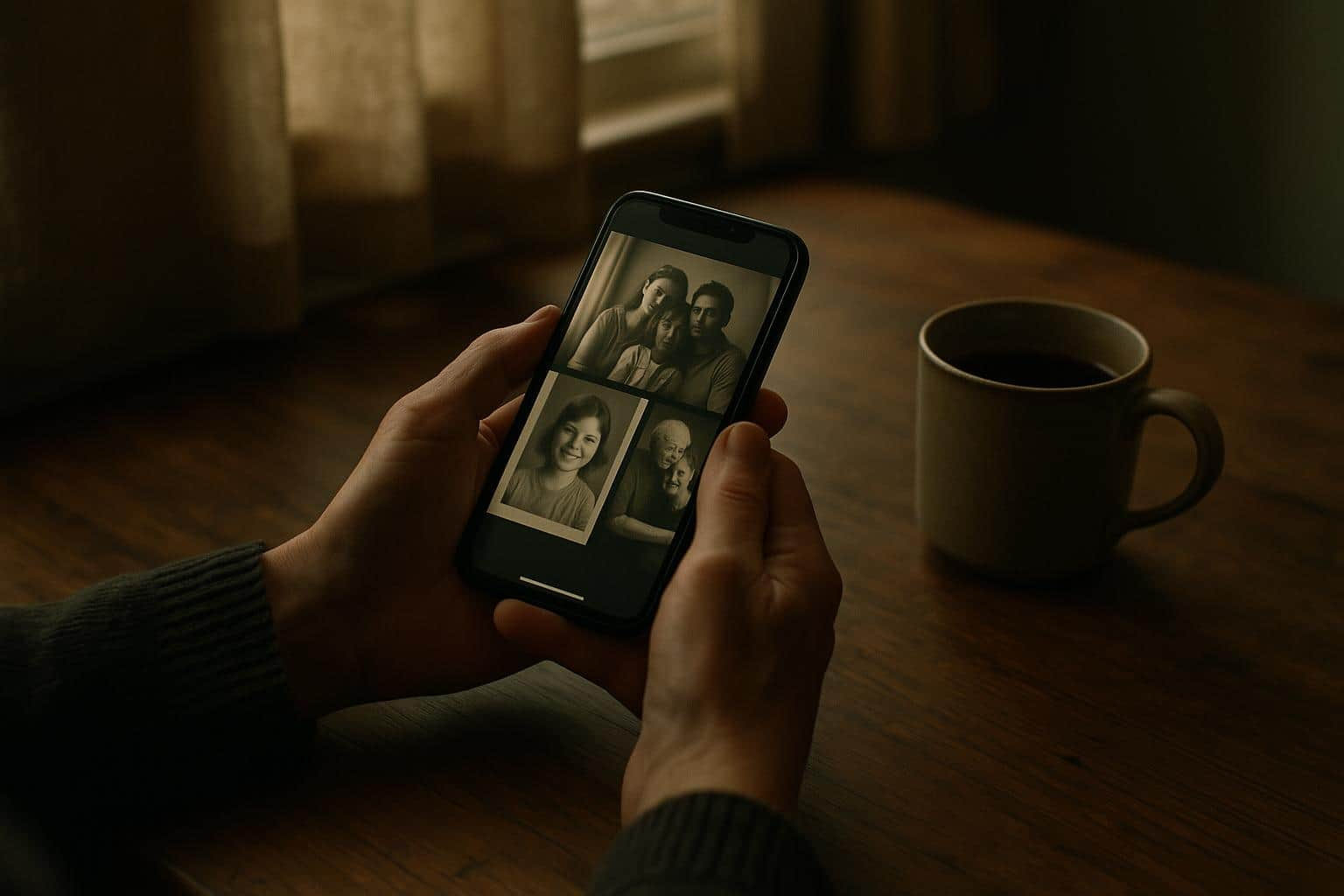Table of contents
- When Death Meets the Digital World
- The Paradox of Digital Immortality
- The Five Stages of Digital Grief
- Managing Digital Triggers and Memories
- Public Grief in the Social Media Age
- Digital Estate Planning: Before It’s Too Late
- Supporting Others Through Digital Grief
- Children and Digital Grief
- The Future of Digital Grief
- Conclusion: Living Fully in a Digital World
- References
When Death Meets the Digital World

At 3:47 AM, Sarah’s phone buzzed with a cheerful Facebook prompt: “It’s been a while since you and Michael shared memories. Want to create a new one together?” But Michael had died three months earlier. That message didn’t just sting—it shattered her. The algorithm didn’t know he was gone. It couldn’t.
This story, echoed by countless others, captures the strange new reality of grief in the digital age. For the first time in history, we grieve in a world where the dead maintain online lives—profiles, photos, posts—that continue long after they’re gone. Algorithms resurface memories without warning. Public platforms turn private pain into shared content.
The numbers are staggering. Over 30 million Facebook accounts belong to the deceased. Memorialized profiles draw over 30 million views a month. By 2070, the dead may outnumber the living on the platform. Hashtags like #grief, used millions of times, reveal a global, ongoing conversation about loss—and our need to process it online.
Yet most people are unprepared for this kind of mourning. Traditional grief models weren’t built for a world where birthdays, memories, and photos keep appearing after death. This evolving digital presence complicates our healing process—and challenges us to rethink how we say goodbye.
This guide explores the emotional, psychological, and practical sides of digital grief. It offers strategies for navigating algorithmic triggers, managing digital legacies, and honoring loved ones in an online world.
The Paradox of Digital Immortality
In the past, death marked a clean break—physical presence ended, belongings were passed on, and memories lived in the hearts of the living. Today, that boundary is blurred. Our digital lives linger, creating “digital ghosts” that continue to exist online after we’re gone.
This is the paradox of digital immortality: it offers both comfort and complication. On one side, social media helps preserve memories—photos, messages, and shared moments can provide a deep sense of connection to those we’ve lost. But for many, these constant digital reminders also make it harder to fully process loss. The deceased may be physically gone, but online, they still “exist”—tagged in photos, suggested in friend lists, or resurfacing through memory notifications.
Social media algorithms, designed for engagement, don’t recognize death. They keep serving up posts and prompts as if the person were still alive. A 2024 study revealed that over 70% of grieving individuals encountered unexpected, sometimes distressing, digital interactions with deceased loved ones. For some, this ongoing presence is healing. For others, it reopens wounds.
This can complicate grief. Traditional models assume the loved one’s presence gradually fades. Digital platforms interrupt that natural decline by maintaining—and even amplifying—their presence over time.
It also raises ethical questions. Most people don’t plan how their digital life will be handled after death. Their families are left to decide what to keep, delete, or memorialize—often without guidance.
Digital immortality can be a source of connection or a barrier to healing. The key lies in managing it with care—balancing memory with acceptance, presence with peace, and ensuring technology supports, rather than stalls, the journey through grief.
The Five Stages of Digital Grief

While Elisabeth Kübler-Ross’s five stages of grief—denial, anger, bargaining, depression, and acceptance—remain relevant in the digital age, they manifest in distinctly new ways when filtered through social media platforms, digital archives, and online communities. Understanding these digital adaptations can help both grieving individuals and their support networks navigate the unique challenges of 21st-century loss.
Digital Denial: “They’re Still Posting”
In the digital realm, denial takes on a particularly complex form because the deceased’s online presence continues to feel active and alive. Their profile photos remain unchanged, their posts stay visible, and their digital footprint suggests ongoing presence rather than absence. This creates what researchers term “presence bleed”—the psychological phenomenon where digital artifacts make the reality of death feel less definitive [7].
Digital denial manifests in several ways. Grieving individuals may continue to send messages to the deceased’s accounts, expecting responses. They might interpret random algorithmic activity—such as old posts being reshared by the platform—as signs that their loved one is somehow still present. Some report feeling that the person isn’t really gone because their social media presence remains so vivid and accessible.
The challenge of digital denial is compounded by the way social media platforms handle death. Unlike physical spaces that clearly change after someone dies, digital spaces often remain frozen in time, creating an illusion of suspended animation rather than finality. This can extend the denial phase significantly, as the normal environmental cues that reinforce the reality of death are absent in digital spaces.
Digital Anger: Rage at the Algorithm
The anger stage of digital grief often focuses on the technology itself rather than the loss. Bereaved individuals frequently express fury at platforms that continue to send notifications about the deceased, suggest connecting with them, or surface painful memories at inappropriate times. This technological anger represents a new category of grief response that didn’t exist in pre-digital mourning.
Common targets of digital anger include birthday reminders for deceased loved ones, “memories” features that surface photos at triggering moments, and friend suggestions that include the deceased person. Many report feeling that the platform is “mocking” their loss or demonstrating a callous disregard for their pain. This anger can be particularly intense because it feels like the technology is actively working against their healing process.
The impersonal nature of algorithmic interactions amplifies this anger. Unlike human interactions, where inappropriate comments or actions can be addressed directly, algorithmic “insensitivity” feels both pervasive and unchangeable. People report feeling helpless against systems that seem designed to maximize engagement without considering the emotional impact on grieving users.
Digital Bargaining: Desperate Preservation
Digital bargaining often involves frantic efforts to preserve and control the deceased’s digital presence. This might include downloading every photo, saving all conversations, or creating elaborate digital archives. The bargaining mind believes that if enough digital artifacts can be preserved, the loss can somehow be mitigated or the person can be kept “alive” in digital form.
This stage frequently involves negotiations with platform policies and technical limitations. People may spend hours researching how to access locked accounts, preserve content before it disappears, or maintain the deceased’s digital presence exactly as it was. The bargaining often extends to magical thinking about digital preservation—believing that keeping every digital trace intact will somehow maintain the relationship or prevent the finality of loss.
Some individuals in this stage become obsessed with digital estate planning for themselves, driven by the fear that their own digital death might cause similar pain for their loved ones. They may create elaborate systems for password sharing, digital asset management, and posthumous social media management, believing that perfect digital death planning can somehow bargain away the pain of loss.
Digital Depression: Isolation Despite Connection

The depression stage of digital grief presents a unique paradox: feeling profoundly alone while being more connected than ever before. Social media platforms, designed to foster connection, can become sources of isolation for the grieving. The curated happiness of others’ feeds can feel alienating when contrasted with personal loss, and the pressure to perform normalcy online can be exhausting.
Digital depression often involves withdrawing from online spaces that once brought joy. People may stop posting, avoid social media entirely, or feel overwhelmed by the gap between their internal experience and the cheerful facade expected in digital spaces. The deceased’s continued digital presence can serve as a constant reminder of loss, making it difficult to find respite from grief even in online environments that were previously sources of comfort.
The asynchronous nature of digital communication can exacerbate feelings of depression. Unlike face-to-face interactions where support can be immediate and responsive, digital support often feels delayed, superficial, or inadequate. The grieving person may feel that their online community doesn’t truly understand their loss or that digital expressions of sympathy lack the depth and authenticity of in-person support.
Digital Acceptance: Finding Peace with Digital Legacy
Digital acceptance involves developing a healthy relationship with the deceased’s online presence and integrating their digital legacy into the ongoing grief process. This stage is characterized by intentional choices about how to interact with digital memories, when to engage with the deceased’s accounts, and how to honor their memory in online spaces.
People in digital acceptance often develop personal protocols for managing algorithmic triggers. They may choose to memorialize accounts, adjust notification settings, or create specific times for engaging with digital memories. They learn to see the deceased’s digital presence as one part of their legacy rather than a substitute for their physical presence.
This stage also involves finding meaningful ways to continue the relationship through digital means. This might include writing posts to the deceased on significant dates, sharing memories that honor their impact, or using their digital presence as a way to connect with others who knew them. The key difference from earlier stages is that these interactions feel intentional and healing rather than compulsive or painful.
Digital acceptance often includes taking action to help others navigate similar losses. Many people in this stage become advocates for better digital death policies, create resources for digital grief support, or share their experiences to help others understand the unique challenges of mourning in the digital age.
Understanding these five stages of digital grief provides a framework for recognizing that the emotional journey through loss in the digital age follows familiar patterns while presenting entirely new challenges. The goal is not to rush through these stages but to recognize them as normal responses to an abnormal situation—the first generation to grieve in a world where death doesn’t end digital presence.
Managing Digital Triggers and Memories

One of the most challenging aspects of digital grief is the unpredictable nature of algorithmic triggers—those unexpected moments when technology surfaces memories, photos, or reminders of deceased loved ones without warning. Unlike traditional grief triggers that often have predictable patterns or contexts, digital triggers can occur at any time, in any place, and through any connected device.
Understanding Algorithmic Grief Triggers
Social media algorithms are designed to maximize engagement by surfacing content that has historically generated interaction. Unfortunately, these systems cannot distinguish between positive engagement and grief-related distress. When someone dies, their digital content often receives increased attention from friends and family, which signals to algorithms that this content is “engaging” and should be shown more frequently.
The most common algorithmic triggers include anniversary features that surface old photos, friend suggestions that include deceased individuals, birthday reminders, location-based memories that activate when visiting places associated with the deceased, and “people you may know” suggestions that can include the deceased person’s profile. Research from the 2024 Digital Death Survey found that 68% of bereaved individuals experienced at least one distressing algorithmic trigger within the first month after loss [8].
These triggers are particularly challenging because they occur without context or preparation. A person might be having a good day, focused on work or other activities, when suddenly confronted with a painful reminder of their loss. The jarring nature of these experiences can trigger intense grief responses and make it feel like the healing process is constantly being interrupted by technology.
Platform-Specific Settings and Controls
Each major social media platform offers different tools for managing content related to deceased users, though these options are often buried in settings menus and poorly publicized. Understanding and utilizing these controls can significantly reduce the frequency and impact of digital triggers.
Facebook provides several options for managing interactions with deceased users’ content. The platform allows users to “take a break” from seeing posts from specific people, including deceased individuals, without unfriending them. Users can also adjust their timeline and tagging settings to prevent being tagged in posts about the deceased, and they can modify their notification settings to reduce reminders about birthdays and other events.
Instagram offers similar controls, including the ability to mute specific accounts, restrict who can tag you in posts, and adjust story settings to avoid seeing content from particular users. The platform also allows users to hide their activity status, which can be helpful for those who want to browse memories privately without feeling pressure to respond to messages or comments.
LinkedIn, while less commonly associated with personal grief, can present professional triggers when deceased colleagues appear in network suggestions or work anniversary reminders. The platform allows users to remove connections and adjust notification settings to minimize these interactions.
Twitter (now X) provides options to mute keywords, accounts, and conversations that might trigger grief responses. Users can create comprehensive mute lists that include the deceased person’s name, common phrases associated with their death, and related terms that might surface painful content.
Creating Healthy Digital Boundaries

Establishing healthy digital boundaries during grief requires both technical adjustments and personal protocols. The goal is not to eliminate all reminders of the deceased, but to create conditions where encounters with their digital presence feel intentional rather than ambush-like.
The 24-hour rule represents one of the most effective strategies for managing digital grief triggers. When confronted with an unexpected reminder or feeling compelled to engage with the deceased’s digital presence, waiting 24 hours before taking any action allows the initial emotional intensity to subside and enables more thoughtful decision-making. This rule applies to decisions about viewing photos, reading old messages, posting memorial content, or making changes to digital memorials.
Creating designated times for digital remembrance can help transform random triggers into intentional acts of memory. Some people establish weekly or monthly “digital visits” where they deliberately engage with their loved one’s social media presence, view photos, or read old conversations. Having these scheduled times can reduce the emotional impact of unexpected encounters because there’s a designated space for grief processing.
Developing a support protocol for digital triggers involves identifying trusted friends or family members who can provide immediate support when painful digital encounters occur. This might include having someone available for phone calls, text support, or in-person visits when triggers create intense grief responses. Some people create group chats specifically for sharing and processing digital grief experiences with others who understand the unique challenges involved.
The Importance of Digital Detox Periods
Regular breaks from digital platforms can be crucial for grief processing, particularly during the acute phases of loss. Digital detox periods allow the nervous system to reset and provide space for grief to unfold without constant technological interruption. These breaks don’t need to be permanent or comprehensive—even short periods of reduced digital engagement can provide significant relief.
Some people find benefit in “grief sabbaticals” from social media, temporarily deactivating accounts or using apps that block access to triggering platforms. Others prefer more targeted approaches, such as avoiding specific platforms while maintaining others, or using digital wellness tools to limit daily usage during particularly difficult periods.
The key to effective digital boundary setting is recognizing that these boundaries may need to change over time. What feels protective and helpful in the immediate aftermath of loss may feel restrictive or isolating months later. Regularly reassessing and adjusting digital boundaries ensures that technology supports rather than hinders the grief process as it evolves.
Understanding that digital triggers are a normal part of modern grief helps reduce the additional distress that can come from feeling ambushed by technology. By taking proactive steps to manage these triggers and creating intentional spaces for digital remembrance, grieving individuals can maintain meaningful connections to their loved ones’ digital legacy while protecting their emotional wellbeing during the healing process.
Public Grief in the Social Media Age

The rise of social media has fundamentally transformed grief from a primarily private experience to one that often unfolds in public digital spaces. This shift has created new opportunities for connection and support, but it has also introduced complex challenges around authenticity, privacy, and the performance of mourning in online environments.
The Performance of Grief Online
Social media platforms, by their very nature, encourage the curation and presentation of experience for public consumption. When grief enters these spaces, it inevitably becomes subject to the same performative pressures that characterize other forms of social media content. This creates what researchers call “grief performance”—the conscious and unconscious ways that mourning is shaped by the expectations and norms of digital platforms [9].
The performance of grief online manifests in various ways. People may feel pressure to post about their loss to make it “real” or to receive social validation of their pain. They might carefully curate which aspects of their grief to share, presenting only the most socially acceptable or inspiring elements while hiding the messier, more difficult parts of mourning. Some individuals report feeling that their grief isn’t legitimate unless it’s acknowledged and validated by their online community.
This performative aspect can create additional stress during an already difficult time. The grieving person must not only process their loss but also consider how to present that loss to their digital audience. Questions arise about timing: When is it appropriate to post about the death? How long should one wait before sharing “normal” content again? What tone should memorial posts take? These decisions can feel overwhelming when someone is already struggling with the basic tasks of daily life during grief.
The visual nature of many social media platforms adds another layer of complexity to grief performance. Choosing the “right” photo to memorialize someone, deciding whether to smile in photos taken after a loss, or determining how to visually represent the ongoing impact of grief all require emotional labor that previous generations of mourners didn’t face.
Managing Unwanted Advice and Comments
One of the most challenging aspects of public grief is managing the well-intentioned but often unhelpful responses from online communities. Social media’s comment culture, which encourages quick reactions and advice-giving, can be particularly problematic when applied to grief content. Grieving individuals frequently report feeling overwhelmed by the volume of responses to their posts and frustrated by comments that minimize their loss or offer unsolicited advice.
Common problematic responses include platitudes like “everything happens for a reason,” comparisons to others’ losses, advice about moving on or finding closure, religious or spiritual interpretations that don’t align with the grieving person’s beliefs, and attempts to find silver linings or positive aspects of the loss. While these responses are typically well-intentioned, they can feel invalidating and add to the grieving person’s emotional burden.
The public nature of social media comments also means that inappropriate responses are visible to the grieving person’s entire network, potentially creating additional embarrassment or conflict. Some people report feeling that they need to manage others’ reactions to their grief, responding graciously to unhelpful comments to maintain social relationships even when those comments are causing additional pain.
Developing strategies for managing online grief responses becomes crucial for protecting emotional wellbeing. Some effective approaches include setting clear boundaries about what kind of support is helpful, using platform tools to limit who can comment on posts, creating private groups for sharing more vulnerable aspects of grief, and having trusted friends help moderate comments on particularly sensitive posts.
Creating Supportive Online Communities

Despite the challenges of public grief, social media platforms also offer unprecedented opportunities for connection and support during loss. Online grief communities can provide 24/7 support, connect people with others who have experienced similar losses, and offer resources and information that might not be available locally.
Effective online grief support communities typically share several characteristics. They maintain clear guidelines about respectful communication and appropriate responses to grief and create spaces for different types of grief expression, recognizing that people mourn in diverse ways. They provide both immediate crisis support and long-term community for ongoing grief processing. Also, they connect online support with offline resources and professional help when needed.
Many people find that online grief communities offer a level of understanding that’s difficult to find in their immediate social circles. Connecting with others who have experienced similar losses—whether the death of a child, suicide loss, sudden death, or other specific circumstances—can provide validation and practical advice that general support networks cannot offer.
The asynchronous nature of online support can also be beneficial for grieving individuals. Unlike in-person support groups that meet at specific times, online communities allow people to seek and offer support when they need it most, whether that’s at 3 AM during a sleepless night or during a lunch break when grief suddenly feels overwhelming.
Balancing Authenticity with Privacy
One of the most complex aspects of navigating public grief is finding the right balance between authentic expression and personal privacy. Social media encourages sharing and connection, but grief often involves experiences that feel too raw, personal, or complex for public consumption.
Many people develop strategies for sharing different aspects of their grief in different digital spaces. They might use Facebook for general updates and memorial posts, Instagram for visual memories, private group chats for more vulnerable expressions of pain, and professional platforms like LinkedIn for work-related aspects of their loss. This multi-platform approach allows for more nuanced grief expression while maintaining appropriate boundaries.
The concept of “grief authenticity” in digital spaces is complicated by the fact that all social media content is, to some degree, curated and performed. The question becomes not whether to be authentic, but how to be authentically oneself within the constraints and opportunities of digital platforms. This might mean being honest about the ongoing nature of grief, sharing both difficult and beautiful memories, or acknowledging the complexity of emotions that accompany loss.
Some individuals choose to be very open about their grief journey, using their platforms to educate others about loss and advocate for better grief support. Others prefer to keep their mourning more private, sharing only occasional updates or memorial posts. Both approaches are valid, and the key is finding what feels right for each individual’s personality, circumstances, and support needs.
The evolution of public grief in the social media age reflects broader changes in how we understand privacy, community, and emotional expression in digital spaces. While these changes present new challenges, they also offer new possibilities for connection, support, and meaning-making during some of life’s most difficult experiences.
Digital Estate Planning: Before It’s Too Late

The reality of digital death planning is stark: most people will die with dozens of online accounts, thousands of digital photos, important documents stored in cloud services, and valuable digital assets—yet fewer than one-third of account holders have made any provisions for what happens to these digital assets after death [10]. This lack of planning creates significant challenges for grieving families who must navigate complex platform policies, legal requirements, and technical barriers while processing their loss.
The Reality of Digital Assets
Modern digital lives encompass far more than social media profiles. The average person’s digital estate includes email accounts containing years of correspondence, cloud storage services with family photos and important documents, financial accounts and cryptocurrency wallets, subscription services and digital media libraries, professional accounts and business-related digital assets, and gaming accounts with virtual goods and achievements that may have significant monetary or sentimental value.
The 2024 Digital Death Survey revealed that the average adult maintains accounts on 12-15 different platforms, with many people underestimating the full scope of their digital presence [11]. These digital assets often have both financial and emotional value, making their proper management crucial for both practical and psychological reasons.
Digital assets also include less obvious elements such as domain names, intellectual property stored online, digital art and creative works, online business assets, and even digital loyalty points and rewards that can have monetary value. The complexity of modern digital estates means that comprehensive planning requires careful inventory and consideration of multiple types of digital property.
Creating a Digital Death Plan
Effective digital estate planning begins with creating a comprehensive inventory of all digital accounts and assets. This inventory should include platform names and associated email addresses, usernames and account recovery information, the location of important digital files, subscription services and their billing information, and any accounts with financial or sentimental value.
The next step involves deciding what should happen to each digital asset after death. Options typically include account deletion, memorialization or preservation, transfer to specific family members, or conversion to legacy accounts with limited functionality. Different platforms offer different options, and understanding these choices is crucial for making informed decisions.
Creating a digital death plan also requires considering the emotional impact on survivors. Some digital content might be comforting for family members to access, while other content might be private or potentially distressing. Thoughtful digital estate planning takes these emotional considerations into account, providing guidance about what content should be preserved, shared, or deleted.
Documentation is crucial for digital estate planning. This includes creating a secure document that lists all accounts and access information, specifying wishes for each digital asset, identifying trusted individuals who should have access to different types of digital content, and providing instructions for accessing and managing digital assets. This documentation should be stored securely but accessibly, with trusted individuals knowing how to locate it when needed.
Password Management and Access Planning

One of the most practical challenges in digital estate planning is ensuring that trusted individuals can access digital accounts when needed. Traditional password management often fails after death because the deceased is no longer available to provide authentication or answer security questions.
Effective password management for digital estate planning involves using a reputable password manager that offers emergency access features, creating a master document with account information stored securely offline, establishing legacy contacts on platforms that offer this feature, and ensuring that trusted individuals know how to access password management systems.
Many password managers now offer “emergency access” features that allow designated individuals to request access to accounts after a specified waiting period. This provides a balance between security during life and accessibility after death. However, these features require advance setup and regular maintenance to remain effective.
The legal landscape around digital asset access varies significantly by jurisdiction, and families may face significant barriers to accessing deceased loved ones’ accounts even with proper documentation. Understanding local laws and platform policies is crucial for effective digital estate planning.
Communicating Wishes to Family
One of the most important—but often overlooked—parts of digital estate planning is clearly communicating your wishes to loved ones. Many people create thoughtful plans for their digital legacy, but never share them. This silence can leave family and friends unsure of what to do, especially during a time of grief.
Effective communication means more than writing down passwords or naming digital executors. It involves open conversations about your digital legacy—what you want preserved, deleted, or memorialized—and who should handle each part. It also means making sure loved ones know where to find these plans and how to use them.
Some families hold regular “digital death check-ins” to talk about new accounts, updated wishes, or changes in access. These conversations may feel strange at first, but they build understanding, reduce confusion, and offer peace of mind over time.
It’s also important to talk about the emotional side. Managing a deceased loved one’s digital presence can be triggering. Letting your family know your preferences—whether you want your social media memorialized, your emails deleted, or your photos saved—helps them make decisions with more clarity and less guilt.
Digital estate planning isn’t just about control—it’s about care. By having these conversations, you’re easing a future burden and helping your loved ones navigate both grief and technology with more confidence and less stress. It’s a gift of clarity during one of life’s most overwhelming times.
Supporting Others Through Digital Grief

Supporting someone through digital grief requires understanding both traditional grief support principles and the unique challenges that technology introduces to the mourning process. Well-intentioned friends and family members often struggle with how to offer appropriate support in digital spaces, particularly when their own relationship with the deceased and their comfort with technology may differ significantly from the grieving person’s experience.
What to Say (and Not Say) on Social Media
Digital grief support requires careful consideration of language, timing, and platform-appropriate responses. Unlike in-person conversations where tone, body language, and immediate feedback help guide interactions, digital communications lack these contextual cues and can easily be misinterpreted or feel inadequate to the grieving person.
Effective digital grief support focuses on acknowledgment rather than advice. Simple statements like “I’m thinking of you,” “Your love for [name] is evident in everything you share,” or “Thank you for letting us remember [name] with you” provide support without imposing expectations or interpretations on the grieving person’s experience. These responses validate the person’s loss and their choice to share their grief publicly without attempting to fix or minimize their pain.
Conversely, responses to avoid include anything that attempts to find meaning or purpose in the loss, comparisons to other losses or experiences, advice about moving forward or finding closure, religious or spiritual interpretations unless you know they align with the person’s beliefs, and attempts to redirect focus to positive aspects or silver linings. These responses, while often well-intentioned, can feel invalidating and add to the grieving person’s emotional burden.
The “Like” Dilemma and Digital Etiquette
One of the most common questions about digital grief support involves whether and how to respond to posts about loss. The “like” button presents a particular dilemma—does liking a post about someone’s death seem inappropriate or callous? How should one respond to ongoing posts about grief and remembrance?
Most grief experts suggest that engagement with grief-related posts should be guided by the relationship with the grieving person and the tone of their post. A simple “like” can serve as acknowledgment and support, particularly for posts that celebrate the deceased’s life or share positive memories. For posts expressing pain or struggle, a more thoughtful comment or private message might be more appropriate than a simple reaction.
The key is consistency and authenticity in digital grief support. If you typically engage with someone’s posts, continuing to do so during their grief can provide a sense of normalcy and ongoing connection. However, if you rarely interact with their content, suddenly becoming very active in response to their loss might feel performative or overwhelming.
Long-term Digital Grief Support
Digital grief support extends far beyond the immediate aftermath of loss. Social media’s persistent nature means that grief-related content continues to appear in feeds, and the grieving person’s needs for support evolve over time. Long-term digital grief support requires understanding that grief doesn’t follow a predictable timeline and that different types of support may be needed at different stages.
Ongoing digital support might include remembering and acknowledging significant dates like birthdays, anniversaries, or holidays, sharing your own memories of the deceased when appropriate, continuing to engage with the grieving person’s non-grief-related content to maintain normal social connection, and being available for private digital communication when public support feels insufficient.
Children and Digital Grief

Children’s experience of digital grief presents unique challenges that require special consideration from parents, educators, and mental health professionals. Today’s children are growing up as digital natives, but their developmental stage affects how they understand both death and digital permanence in ways that can complicate their grief process.
How Digital Grief Differs for Children
Children’s cognitive development affects their understanding of digital death in several key ways. Young children may not understand that a deceased person’s continued digital presence doesn’t mean they’re still alive, leading to confusion about the finality of death. They might expect the deceased to respond to messages or become distressed when digital interactions don’t occur as expected.
Adolescents face different challenges, often feeling pressure to perform their grief appropriately on social media or struggling with how to maintain their own digital presence while processing loss. They may also encounter inappropriate content about the deceased or experience cyberbullying related to their loss, adding additional trauma to their grief experience.
The permanence of digital content can be particularly challenging for children, who may not understand that their posts about grief will remain visible indefinitely. This can create future embarrassment or regret about how they expressed their grief during childhood, particularly as their understanding of death and their relationship with the deceased evolves over time.
Age-Appropriate Digital Memorial Activities
Creating meaningful digital memorial activities for children requires balancing their developmental needs with the opportunities that technology provides for memory-making and connection. For younger children, simple activities like creating digital photo albums, recording video messages to the deceased, or participating in family-led digital memorial projects can provide comfort and help process their loss.
Older children and adolescents might benefit from more sophisticated digital memorial activities such as creating websites or social media pages dedicated to the deceased, participating in online fundraising for causes related to their loss, or connecting with other young people who have experienced similar losses through moderated online support groups.
The key is ensuring that digital memorial activities are supervised, age-appropriate, and focused on healing rather than performance. Children should be helped to understand the permanent nature of digital content and given guidance about what kinds of memorial activities might feel meaningful both now and in the future.
The Future of Digital Grief

As technology continues to evolve at an unprecedented pace, the landscape of digital grief is rapidly changing. Emerging technologies promise to further transform how we experience loss, remember the deceased, and support each other through grief, while also raising new ethical questions and challenges for grieving individuals and their communities.
Emerging Technologies and Their Impact
Artificial intelligence is beginning to play an increasingly significant role in digital grief, with AI systems now capable of preserving and recreating deceased individuals’ personalities with remarkable accuracy. “Griefbots” or “thanabots”—AI systems trained on a deceased person’s digital communications—can simulate conversations with the dead, raising profound questions about the nature of memory, relationship, and healing [12].
Virtual and augmented reality technologies are creating new possibilities for digital memorialization and grief processing. Virtual memorial spaces allow families to create immersive environments for remembering loved ones, while augmented reality applications can overlay digital memories onto physical spaces, creating new forms of presence and connection with the deceased.
Blockchain technology is beginning to address some of the permanence and access issues in digital grief by creating decentralized, permanent records of digital memorials and ensuring that digital assets can be transferred according to predetermined wishes without relying on platform policies or corporate decisions.
Ethical Considerations and Preparing for Change
The rapid evolution of digital grief technologies raises important ethical questions about consent, authenticity, and the nature of healthy grief processing. As AI systems become more sophisticated at simulating deceased individuals, questions arise about whether such interactions support or hinder the grief process, who has the right to create and control these digital representations, and how to balance the desires of different family members who may have conflicting views about digital memorialization.
The future of digital grief will likely require new frameworks for understanding healthy mourning in technological contexts, updated legal structures for managing digital assets and AI representations of the deceased, and enhanced digital literacy to help people navigate increasingly complex technological grief landscapes.
Preparing for these changes involves staying informed about emerging technologies and their implications for grief, engaging in ongoing conversations about digital death and memorialization preferences, and advocating for ethical development of grief-related technologies that prioritize human wellbeing over technological capability.
Conclusion: Living Fully in a Digital World
Grief today unfolds in a digital landscape where memories live online, algorithms resurface past moments, and traditional mourning rituals must adapt. We’re the first generation navigating loss in a world where the dead often remain digitally present—on social media, in photo archives, and through online messages that linger.
Digital grief isn’t about choosing between healing and technology—it’s about using technology in thoughtful, supportive ways. That means managing digital triggers, setting healthy boundaries online, and finding meaningful ways to honor loved ones while protecting your emotional wellbeing.
From the millions of digital profiles left behind to the rise of virtual grief support, it’s clear that this experience is shared. Communities are forming in new ways, and people are reimagining how to remember, connect, and heal in digital spaces.
Technology can complicate grief—but it can also comfort. It allows 24/7 support, preserves precious memories, and creates ongoing connections with those we’ve lost. The key is intentional use: recognizing that digital grief carries familiar emotions alongside new challenges, and knowing there’s no one “right” way to grieve online.
Looking ahead, technologies like AI and VR will further reshape how we remember, mourn, and heal—bringing both opportunities and ethical questions. The goal isn’t to escape digital life during grief but to move through it wisely, with compassion for ourselves and others.
As digital death becomes more common, learning to grieve well online becomes both a personal skill and a collective responsibility. By approaching it with awareness and care, we can honor the past, support each other, and build a future where grief—and love—have space to be fully felt.
References
[1] Meta Transparency Center. (2024). Memorialization Statistics. Retrieved from https://transparency.meta.com/policies/community-standards/memorialization/
[2] Öhman, C., & Watson, D. (2019). Are the dead taking over Facebook? A Big Data approach to the future of death online. Big Data & Society, 6(1). https://journals.sagepub.com/doi/10.1177/2053951719842540
[3] Los Angeles Outpatient Center. (2024). Grief Statistics in the United States. Retrieved from https://laopcenter.com/mental-health/grief-statistics/
[4] Brubaker, J. R., & Vertesi, J. (2010). Death and the social network. Proceedings of the SIGCHI Conference on Human Factors in Computing Systems. https://dl.acm.org/doi/10.1145/1753326.1753567
[5] Digital Legacy Association. (2024). Digital Death Survey 2024. Retrieved from https://digitallegacyassociation.org/digital-death-survey-2024/
[6] Brubaker, J. R. (2019). Digital afterlives: Understanding posthumous digital interaction. Death Studies, 43(4), 231-239.
[7] Kasket, E. (2019). All the Ghosts in the Machine: Illusions of Immortality in the Digital Age. Robinson Publishing.
[8] Digital Legacy Association. (2024). Digital Death Survey 2024 – Preliminary Dataset. Retrieved from https://digitallegacyassociation.org/about/reports-2/
[9] Gibbs, M., Meese, J., Arnold, M., Nansen, B., & Carter, M. (2015). #Funeral and Instagram: Death, social media, and platform vernacular. Information, Communication & Society, 18(3), 255-268.
[10] Epilogue Wills. (2024). What Happens To Your Facebook Account After You Die? Retrieved from https://epiloguewills.com/blog/what-happens-to-your-facebook-after-you-die
[11] Digital Legacy Association. (2024). Digital Death Survey 2024. Retrieved from https://digitallegacyassociation.org/digital-death-survey-2024/
[12] Savin-Baden, M., Burden, D., & Taylor, H. (2017). The ethics and impact of digital immortality. Knowledge Cultures, 5(2), 178-196.


